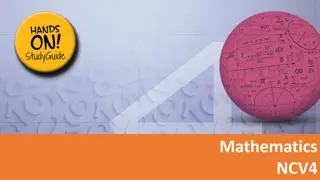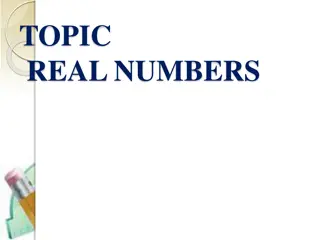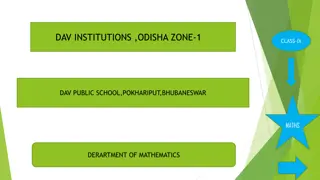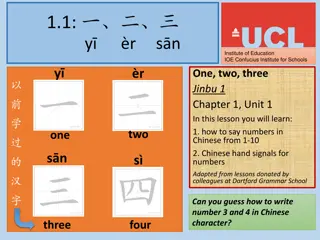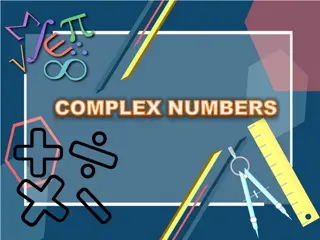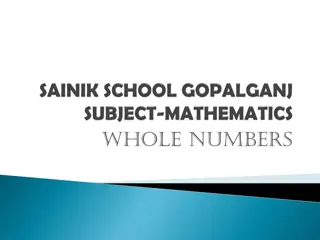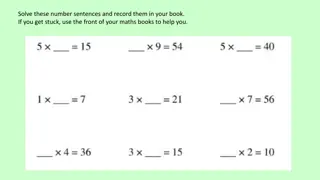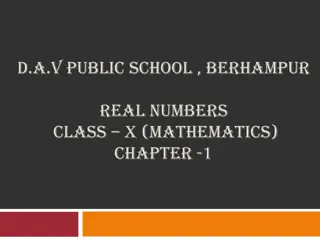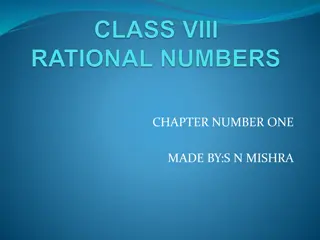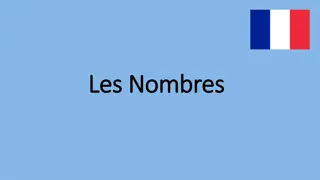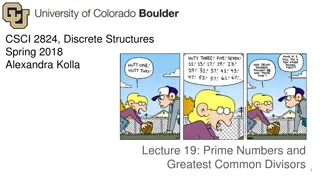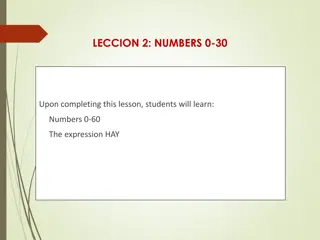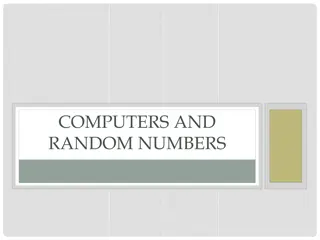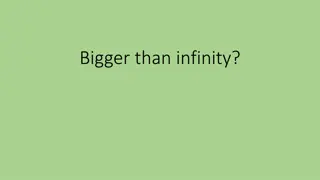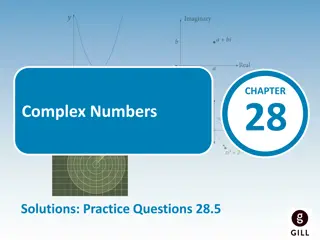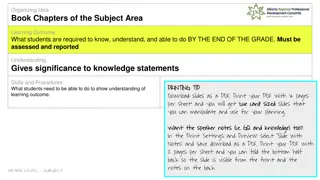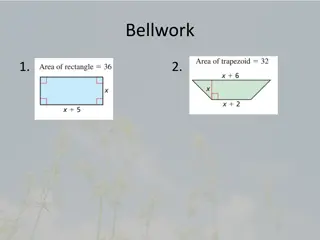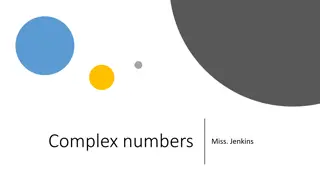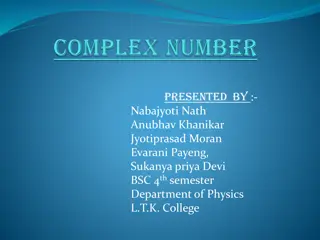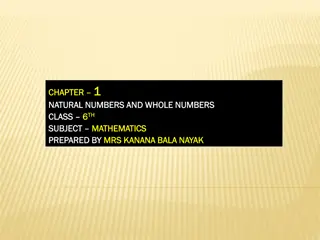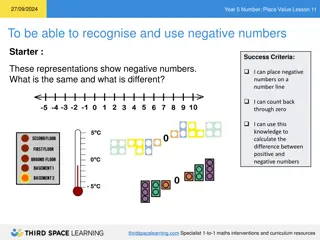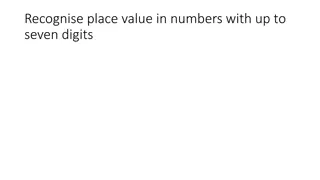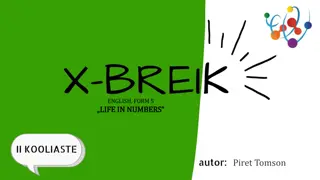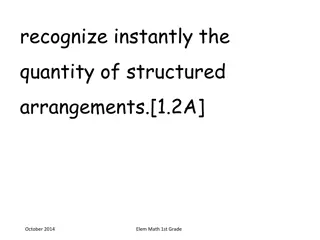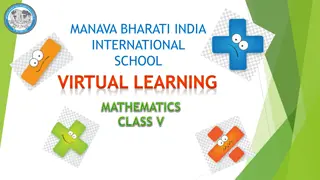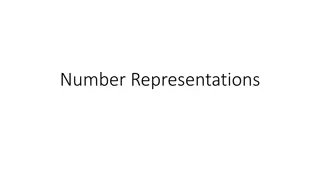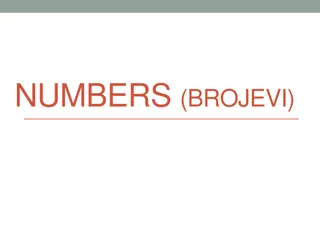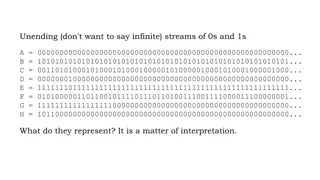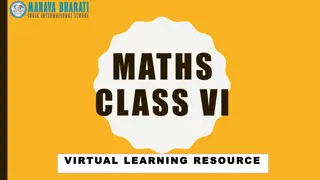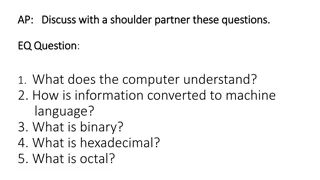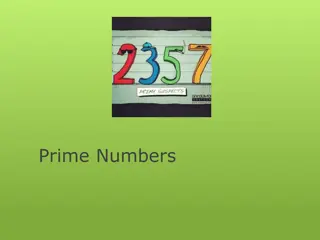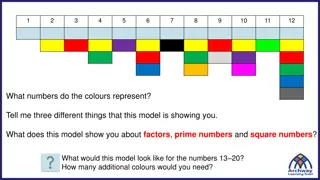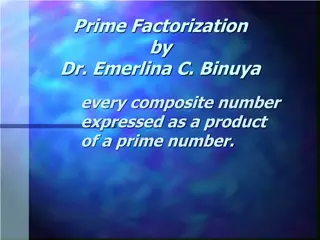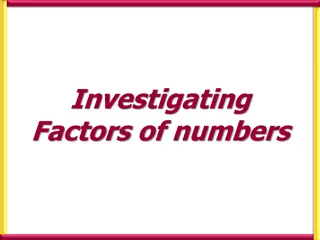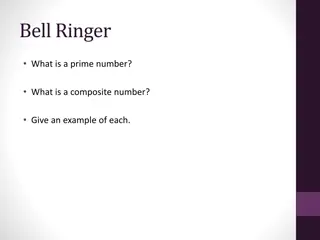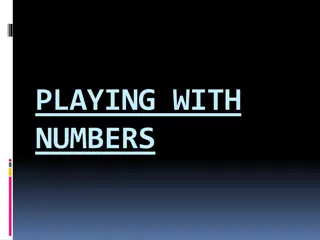RATIONAL NUMBER ARITHMETIC. Day 1: Interpreting Negative Numbers
Explore the concept of negative numbers through practical scenarios such as temperature readings and elevation differences. Learn how to compare rational numbers and describe measurements in relation to sea level, all while engaging in group activities and exercises. Enhance your understanding of ne
1 views • 8 slides
Complex Numbers and Functions in Mathematics
Explore the concept of complex numbers, their operations like addition, subtraction, and multiplication, as well as De Moivre's theorem for raising complex numbers to powers. Dive into solving problems using complex numbers and understanding functions, algebra, and the remainder and factor theorems
12 views • 45 slides
Real Numbers and Number Systems
Dive into the world of real numbers with topics ranging from the definition of real numbers to Euclid's Division Algorithm and the Fundamental Theorem of Arithmetic. Discover the properties of rational and irrational numbers, learn to find the highest common factor (HCF) and least common multiple (L
1 views • 37 slides
Visualizing Real Numbers on a Number Line
The procedure of representing real numbers on a number line through successive magnification is explained in detail. It involves dividing the line, marking points, and magnifying specific intervals to accurately position numbers like 5.2316. Each real number corresponds to a unique point on the numb
0 views • 12 slides
Rational and Irrational Numbers in Mathematics
Explore the concept of rational and irrational numbers in mathematics through defining, distinguishing, computing, representing, and rationalizing these types of numbers. Learn about natural numbers, whole numbers, integers, rational numbers, and irrational numbers with clear examples. Answer common
1 views • 48 slides
Chinese Numbers Learning Lesson at IOE Confucius Institute
Explore how to say numbers in Chinese from 1-10 and learn Chinese hand signals for numbers through an engaging lesson at the Institute of Education (IOE) Confucius Institute for Schools. Discover the characters for numbers 3 and 4 and dive into practice exercises and memory tests to enhance your lea
0 views • 28 slides
Comprehensive Guide to Complex Numbers - Learning Objectives, Key Concepts, and Previous Knowledge Testing
This comprehensive guide provides detailed information on complex numbers, including learning objectives such as identifying complex numbers, applying algebra, understanding properties like conjugates and moduli, finding square roots, and representing in polar form. Key concepts covered include inte
3 views • 27 slides
Whole Numbers and Basic Properties
Whole numbers are a collection that includes natural numbers and zero. They are denoted by the letter W and start from 0, 1, 2, 3, 4, 5, 6, and so on. The successor of a whole number is obtained by adding 1, and the predecessor is obtained by subtracting 1 (except for 0). The number line begins at 0
2 views • 7 slides
Multiplying Three-Digit Numbers by One-Digit Numbers Practice
Practice multiplying three-digit numbers by one-digit numbers with step-by-step instructions and examples to help you correctly set up your calculations and solve them successfully. Use the provided images and solutions to reinforce your understanding of multiplication concepts.
0 views • 5 slides
Real Numbers: Classification, Operations, and Examples
Real numbers encompass a wide range of mathematical entities, including natural numbers, whole numbers, integers, fractions, rational numbers, and irrational numbers. This chapter delves into the classification of real numbers, Euclid's Division Lemma and Algorithm, finding HCF and LCM using these m
4 views • 15 slides
Rational Numbers: A Comprehensive Overview
Discover the world of numbers with this comprehensive guide on different types of numbers, focusing on rational numbers. Learn about natural numbers, whole numbers, integers, and how rational numbers are represented on a number line. Dive into the properties of rational numbers and explore the conce
2 views • 19 slides
Learning French Numbers and Patterns
Explore the world of French numbers, from finding missing numbers to understanding the pattern in counting. Discover how the French language uniquely names numbers beyond 60. Dive into the significance of names like "quatre-vingts" and "quatre-vingt-dix" in French numbering. Unravel the mystery behi
0 views • 16 slides
Prime Numbers and Greatest Common Divisors in Discrete Structures
Cryptography relies on prime numbers and the fundamental theorem of arithmetic to ensure security. We explore the concept of prime numbers, composite numbers, and how to test for primality using trial division. The Fundamental Theorem of Arithmetic establishes that every integer can be uniquely fact
1 views • 44 slides
Mastering Numbers in Writing: A Comprehensive Guide
Learn how to effectively use numbers in writing, including when to spell them out and when to use numerals. Discover general rules for formatting numbers in MLA and APA style, as well as guidelines for commas in numbers and dates. With practical examples and clear explanations, this guide will help
0 views • 15 slides
Learning Numbers from 0 to 30 in Spanish
In this lesson, students will learn numbers from 0 to 60 in Spanish. They will understand the expression "HAY" (there is/are) and how to use it with numbers and indefinite articles. The overview covers the usage of numbers in different contexts, including counting, asking how many, and basic additio
0 views • 5 slides
Random Numbers in Computers
Explore the concept of true random numbers versus pseudorandom numbers in computers. Learn how pseudorandom numbers are generated algorithmically but predictable, while true random numbers are derived from physical phenomena like radioactive decay. Discover the relevance of high-entropy pseudorandom
0 views • 57 slides
Infinity: From Countable Integers to the Unbounded Real Numbers
Delve into the realm of infinity, where the concept transcends our finite understanding. Discover how the set of positive integers, even numbers, all integers, positive rational numbers, and real numbers each showcase a distinct level of infinity. Explore the notion of cardinality, bridging the gap
0 views • 9 slides
Practice Questions on Complex Numbers Solutions
This set of practice questions focuses on complex numbers, including finding conjugates, adding, subtracting, and multiplying complex numbers. It also investigates the truth of statements involving operations with given complex numbers.
0 views • 37 slides
Decimal Numbers and Operations in Mathematics
This educational material focuses on teaching students in a structured manner about decimal numbers and operations within the subject of mathematics. It covers essential topics such as place value, addition, subtraction, prime and composite numbers, and more. Students are required to grasp the signi
0 views • 18 slides
Complex Numbers in Mathematics
Learn about complex numbers, including real and imaginary parts, operations with complex numbers, the imaginary unit, equality of complex numbers, and finding square roots of negative numbers. Explore how to define and use the imaginary unit, add, subtract, and multiply complex numbers, find complex
0 views • 17 slides
Complex Numbers in Mathematics
Delve into the world of complex numbers through solving quadratic equations with real coefficients that have complex solutions, extending polynomial identities to include factoring with complex numbers, rewriting expressions, and understanding imaginary numbers. Discover the process of finding compl
0 views • 16 slides
Complex Numbers and Their Properties
Complex numbers are numbers of the form z = x + iy, where x and y are real numbers and i is the imaginary unit. They play a crucial role in mathematics and physics. This content covers the definition, equality, algebra, geometrical representation, and conjugate of complex numbers with detailed expla
0 views • 11 slides
Natural Numbers, Whole Numbers, and Roman Numerals
This chapter delves into the concepts of natural numbers, whole numbers, and Roman numerals. It covers the basics of numeral systems, properties of whole numbers, and rules for Roman numerals. Learn about counting numbers, place value, successors, predecessors, and more to build a strong mathematica
0 views • 11 slides
Negative Numbers in Year 5 Mathematics Lesson
In this Year 5 mathematics lesson on negative numbers, students learn to recognize and use negative numbers through various activities such as placing them on a number line, counting back through zero, and calculating the differences between positive and negative numbers. The lesson also prompts stu
0 views • 23 slides
Place Value and Number Magnitudes
Explore the concept of place value in numbers up to seven digits, learn how to write numbers in figures, identify digit values, find the largest and smallest numbers, order numbers, and work on rounding and comparisons. Engage in exercises like recognizing digits, writing numbers in figures, circlin
0 views • 61 slides
Fun Learning: Life in Numbers with Piret Tomson
Explore the exciting world of numbers with engaging visual aids and exercises in "English Form 5: Life in Numbers" by Piret Tomson. From understanding large numbers to honing quick responses, this interactive resource keeps students entertained while sharpening their math skills.
0 views • 30 slides
Math Concepts for 1st Grade
Explore a variety of math concepts for 1st grade students, including composing and decomposing numbers, generating numbers, using place value, ordering numbers, comparing numbers, and solving word problems. Engage with concrete and pictorial models to enhance understanding and develop foundational m
0 views • 43 slides
Numbers and Comparisons in Mathematics
Dive into the world of numbers with a focus on large numbers, digits, and comparisons in mathematics. Explore the significance of digits, learn rules for comparing numbers, and practice examples to enhance your understanding. Master the art of determining the smallest and greatest numbers based on t
0 views • 13 slides
Binary Representation of Numbers with Fractions
Learn how to represent numbers with fractions in binary form. Discover the process of converting real numbers, like 5.75, into binary by separating the integer and fraction parts. Explore the method of obtaining the binary representation of the fraction through division by specific decimal values. U
0 views • 21 slides
Numbers and Notation in English
Explore the nuances of representing numbers in English, including fractions, decimals, noughts, telephone numbers, cardinal versus ordinal numbers, and the use of "and" in British English. Dive into the significance of punctuation when writing large numbers.
0 views • 11 slides
Binary Numbers and Their Representation in Mathematics
Explore the world of binary numbers through a series of infinite 0s and 1s, representing integers and real numbers between 0 and 1. Dive into the interpretation of these binary sequences as natural numbers, integers, and fractions, shedding light on the concepts of trans-finite numbers and their pla
0 views • 16 slides
Mathematics: Class VI Syllabus Overview & Number Concepts
Delve into the Class VI mathematics syllabus, covering topics such as Knowing our Numbers, Basic Geometrical Ideas, Natural Numbers, and more. Explore the Hindu-Arabic system of numeration, ordering numbers, counting large numbers, and the significance of natural numbers in counting and ordering. En
0 views • 15 slides
Boost Your Business Revenue with Premium Rate Numbers
Looking to monetise your phone services or provide added-value communication? Premium rate numbers are the answer! These special telephone numbers allow businesses to charge users for calls at a higher rate than standard numbers.
8 views • 8 slides
Binary Numbers and Computer Data Representation
A computer stores information digitally as binary numbers, where data is broken down into pieces and represented as numbers. The binary system uses 0s and 1s to encode information, with each bit representing on/off states. This system is crucial for converting data into machine language. Binary numb
0 views • 14 slides
Prime Numbers
Exploring the concept of prime numbers and how to identify them between 1 and 100. The process involves recognizing that prime numbers have only two factors - 1 and themselves. The visual representations help in shading non-prime numbers and multiples of 2, 3, and 5. By following the rules outlined,
1 views • 31 slides
Numbers with Eratosthenes' Sieve and Prime Factorization
Eratosthenes, a Greek scholar, developed the Sieve of Eratosthenes to find prime numbers and made significant contributions to mathematics and astronomy. The model shown highlights factors, prime numbers, and square numbers, providing insights into number properties and their relationships. It demon
27 views • 14 slides
Prime Factorization for Prime and Composite Numbers
Learn about prime and composite numbers, prime factorization, and how to identify them using examples. Discover the concept of factors, prime numbers, composite numbers, and prime factors through this educational presentation. Explore how every composite number can be expressed as a product of prime
2 views • 8 slides
Factors and Prime Numbers in Mathematics
Delve into the concept of factors and prime numbers through an investigation of various numerical values. Understand the distinction between prime numbers and composite numbers, identify prime factors of a number, and explore the significance of prime numbers in mathematics.
1 views • 4 slides
Prime and Composite Numbers with GCF
Explore the concepts of prime and composite numbers, the difference between them, and how to find the Greatest Common Factor (GCF). Prime numbers have only two factors, 1 and the number itself, like 2, 3, 5. Composite numbers have more than two factors, such as 4, 6, 8. Learn to identify prime and c
3 views • 12 slides
Learning Factors, Multiples, and Divisibility Tests
In this chapter, you will dive into understanding factors, multiples, and tests for the divisibility of numbers by various factors like 10, 5, 2, 3, 6, 4, 8, 9, and 11. Explore topics such as highest common factors (HCF), lowest common multiples (LCM), prime numbers, composite numbers, and more. Mas
0 views • 8 slides

